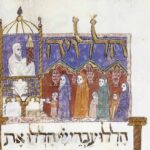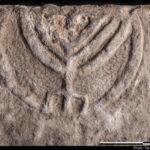In writing my articles on the Haggadah and Seder night, I have had frequent occasion to quote the last perek of Mishnah Pesahim and this has been a source of ongoing frustration. It is very obvious that printed and online editions of the Mishnah are wholly inadequate for use, but it is less obvious what should be used. For a long time, like many others, I used a transcribed copy of the widely-hyped Kaufmann MS but it was clear that this had not a few mistakes and problematic readings in it. So, after far too much dilly-dallying, I finally made an edition for my own use. First, I transcribed all of the MSS that are available online (Kaufmann, Parma, Cambridge, a Geniza fragment, and the Leiden Yerushalmi), adding an MS already transcribed by Rav Sheilat that was used by the Rambam, and copied the Bavli MSS from hachi garsinan, putting everything side by side in a table. You can see the table here. Then I produced my own edition, which you can see here. I hope it helps you prepare for Pesah.
In the process of planning and executing this task, an idea occurred to me based on the following considerations:
- It is now ridiculously easy to do manuscript research. I regularly do so in my lunch break or on the bus, and, in so doing, am able to do research that only a few years ago required a scholar to request an extensive travel budget from his employer. This completely changes the limits of what is possible.
- It is now also very easy to do collaborative work using Google Docs, email, Zoom etc. again enabling ordinary people to work together on projects that until recently would be beyond the budget of research universities.
- The apparatus of a critical edition was designed to fit the maximum amount of information while limited both by the size of each individual page and the weight of the book as a whole, but the internet makes that totally unnecessary. There is no need to compress or omit information. Instead, we can simply place the information all laid out in a table as large as necessary in the backend, and the text for use in the front end.
- Since the beginning of Wissenschaft des Judentums, the goal of scholars has been to produce objective editions of classic works of תורה שבעל פה, a goal given particular urgency by a growing awareness that standard editions of these texts were riddled with errors and anachronisms. Early efforts to achieve this goal, as in other areas of scholarship, followed the eclectic approach, in which a scholar would choose on a case by case basis between all the different manuscript readings based on his own judgment. The problem with this method, obviously, is that it is in inherently subjective. Thus, in the search for objectivity, the eclectic method was replaced by stemmatic method, the scientific study of manuscripts based on an evolutionary model that can track changes in a text back to an original source. The problem with stemmatics is that turns out to be more of a pseudo-science than a science, and, to the extent that its methods are epistemologically sound, there aren’t enough manuscripts of classic Jewish texts to use them. Hence, scholars resigned themselves to the best text method, in which the least-bad manuscript is reproduced faithfully, with variant readings noted underneath in a ‘diplomatic edition’. This is the method used in all the best works, including Shaul Lieberman’s Tosefta, R. Yehoshua Buch’s Yerushalmi, and Menachem Kehana’s Sifrei. This achieves a certain artificial type of objectivity by faithfully reproducing a manuscript that is admitted to be inaccurate in certain respects. The problem with the best-text method, however, is apparent in the very first line of Tosefta Kifshuta, which reads מאמתי קורין את שמע בערבין, משעה שבני אדן נכנסין לוכל פיתן בלילי שבתות. What, you ask, are בני אדן (sons of a socket)? The answer is that they aren’t anything, since as the first comment notes, the correct reading is obviously בני אדם, found in other manuscripts, but not the best one. Even for academic use, using a text like this is extremely tedious. For educational and religious-study purposes it verges on useless.
The ordinary solution to the problem of objectivity in most fields of human endeavour is inter-subjectivity. With the internet, we are now in a position to apply this concept to the production of a new edition of the Mishnah. It would work as follows:
- For each perek, a contributor would do what I have done in my demo, namely transcribe all of the MSS and produce an eclectic edition based on his own considered and informed judgment.
- Then someone else does it again.
- Then the differences between the two versions are collated and each contributor justifies his decisions.
- Where the collaborators come to an agreement, their texts are amended. Each remaining difference is voted upon by the other contributors.
This process can be reiterated an infinite number of times, though I think after attempt number four there will be sharply diminishing returns. However, even after the first iteration of this process, you will end up with a text that is vastly better than the ones in use today. For anyone who has sat with his son memorising mishnayos, patiently (or otherwise) insisting on correct recitation, while privately unsure whether the recitation he insists upon is indeed correct, the value of such a text is obvious. This would not represent a true critical edition, but while such an edition is certainly desirable, it is not what is most urgently required by Jews whose main goal is to learn not not about Torah, but to learn the Torah itself.
Please G-d, I hope to press ahead with this project soon. You do not need perfect judgment or wide bekius to contribute, because this project is based on the principle that two heads are better than one, and three heads better than two. To be more precise, it is based on the observation that everyone makes mistakes, but two different people rarely make exactly the same mistake as each other. All you need is to know a perek well, so pick your favourite one and get cracking. By the time you’ve transcribed it five times, trust me, you’ll know it like the back of your hand. Someone with moderate free time can comfortably do a perek in a month. With 10 volunteers, the first iteration will take ten years, with 50 only 2, with 100, we can wrap it up in one. Just pick your favourite perek and get cracking. Send me an email if you want to make history.



Leave a Reply